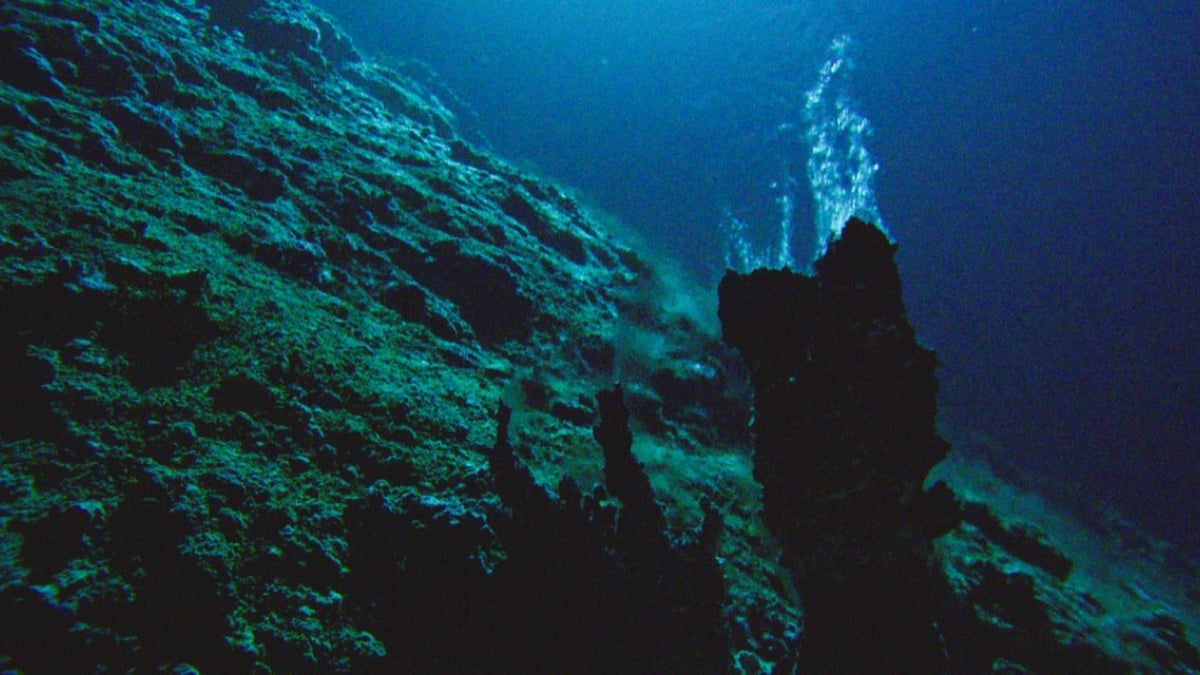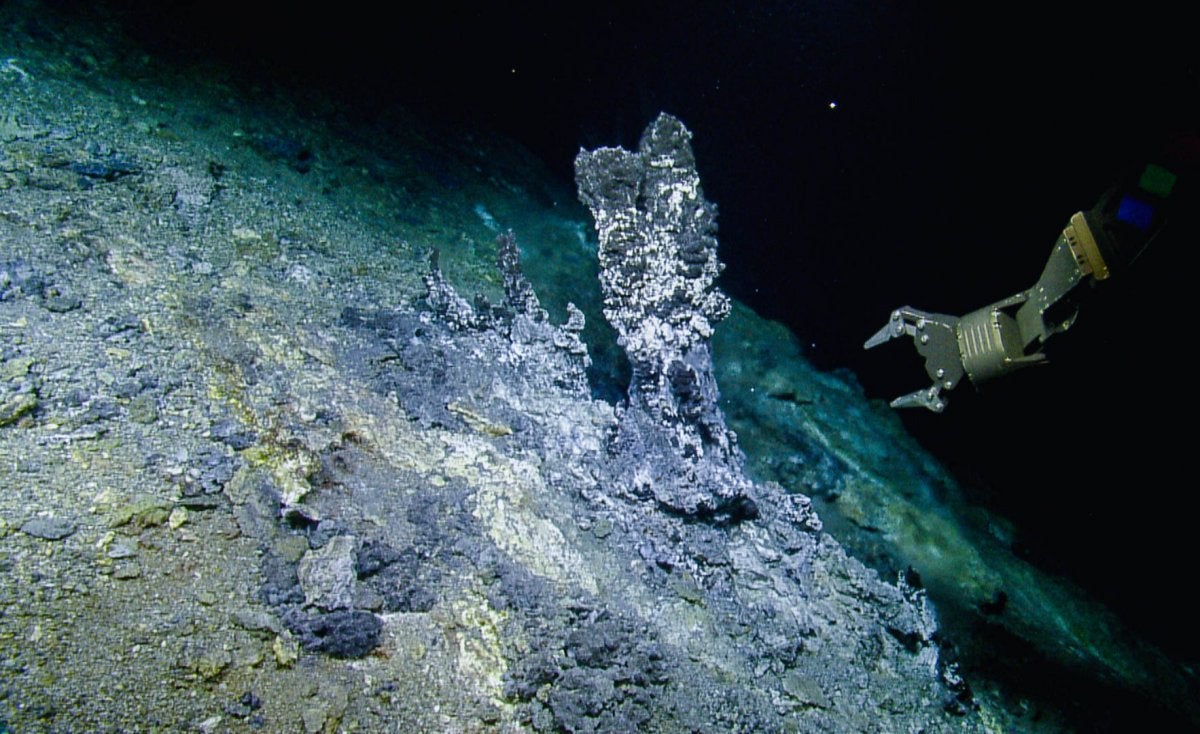One of the most practical ways to explore strange new worlds in our solar system is to go in the opposite direction: to the bottom of the ocean.
Everett Shock spent part of the summer seeing places no one on Earth ever has before. Yes, the mountains have been climbed, deserts crossed and poles reached, but there still are unexplored places to discover.
Shock, an environmental biogeochemist at Arizona State University, just returned from a stint with the Ocean Exploration Trust in Rhode Island. The trust’s ship, Nautilus, explored the submarine hydrothermal systems of the Gorda Ridge off the coast of California. Shock was on the other side of the continent in a mission control room at the trust’s headquarters, interpreting data in real time and consulting with the crew at sea.
The trust was founded in 2008 by Robert Ballard — discoverer of RMS Titanic’s final resting place and a National Geographic Explorer in Residence — to engage in pure ocean exploration. Its international programs center on scientific exploration of the ocean floor with expeditions launched from Exploration Vessel Nautilus, a 64-meter research vessel. Teams use remotely operated vehicles to observe, survey, gather instrument data and collect samples.
The teams pored over the mid-ocean ridge because it is the site of unusual hydrothermal activity. Instead of the normal black or white “smoke” coming from undersea volcanos, these vents spew clear fluids.
Nine thousand feet under the waves, there is no light at all, but plenty of life. Hot water comes out of the vents and mixes with seawater, which gives it a very different composition. It’s far from being in a state of chemical equilibrium with seawater.
The arm of a remotely operated vehicle provides a sense of scale. The vent is perhaps 2 feet high. Vents grow by precipitation until they collapse under their own weight and the cycle of growth begins again. Image courtesy of Ocean Exploration Trust
“As a result, there is energy to be had because there is chemical energy to be harvested by the organisms,” said Shock, who has joint appointments in the School of Molecular Sciences and the School of Earth and Space Exploration and is director of the W. M. Keck Foundation Laboratory for Environmental Biogeochemistry at ASU.
The vents were first discovered in the 1970s. It wasn’t a surprise there’s hot water — there are active volcanos under the water — but geologists discovered there was a lot of biology down there.
“It’s a banquet table of chemical energy sources — and it’s going to be ignored?” said Shock. “It’s like putting a stack of pizzas out on campus with a sign that says ‘free pizza’ and expecting all the students on campus to ignore it. That’s not going to happen. Same thing at the bottom of the ocean with a bunch of chemical energy supplies that can support life. There’s life of every kind down there! It’s just odd to us because it’s not a photosynthetic system. We walk around the surface in the sunlight, so we expect trees and cactus and grass. There’s none of that. It’s a different world.”
The tiny organisms feed on the chemical energy, and then, as tends to happen in the natural world, bigger things eat them and so on up the food chain to tube worms and fish and other critters that are easy to see.
Question: This is pure exploration. What’s it like?
Answer: It’s pretty mesmerizing in a way. I find you can just sort of stare at the screen and watch what the remotely operated vehicle down on the sea floor is sending back. The high-resolution video is pretty amazing. Those vent fields we have been at — well, no actual people have been down there, but submersibles have been down there — just yesterday they discovered hydrothermal venting on another section in another outcrop that is completely new, and in a couple of hours they’re going to go search another spot where they think there might be some. It might not work out, but it would be another thing that would be completely new. There’s serious excitement that goes along with that. These are places on the Earth no one has seen before.
Q: Tell me about your role on the team and what you do every day.
A: I spent the first week in Rhode Island at the headquarters of the ship. They have a mission control setting there. It’s got all these big screens and computer connections and so forth. My role and that of the postdoc who is working with me on this — his name is Vincent Milesi — Vincent and I are in charge of the geochemical modeling, the computational side of things. As data appears from the measurements people are able to make, even on board ship, we are trying to help figure out what that might mean. "We’ve measured the dissolved methane in the water. Great. Let’s see what that might mean." That’s our part in it. On board ship are the people who know how to take those samples and run the (remotely operated vehicle). … We fit into that in that we’re trying various ideas that we get about why the water has the composition that it does, the temperature, everything else, against computer modeling. The computer modeling is really independent of the observations we might make, so it’s a good way of testing things.
Q: How does this work set up the exploration of other worlds, specifically Enceladus, a moon of Saturn, and Europa, a moon of Jupiter, both of which have oceans beneath ice crusts?
A: These worlds are extremely cold. There’s no liquid water at the surface. The liquid water is underneath a bunch of ice. Guess what? It’s going to be dark. On the Earth, one of the places to go to get some sense of what it is we’re actually talking about on these other worlds to do this exploration is the bottom of the ocean. In fact, it is the discovery of all the life around submarine hydrothermal systems … that cause people to think that life on these other worlds is a reasonable thing. Before we knew about that, we thought, "Oh, you’ve got to have photosynthesis. Oh, you’ve got to have water at the surface." … That’s a big deal now with NASA’s efforts to explore these worlds. They realize they need input and suggestions from the ocean science researchers who have never really been involved with NASA programs. It’s a serious effort on many fronts, not just this project, to try to combine ocean exploration with planetary exploration.
Top photo: First video images of the newly discovered Apollo vent field reveal a penumbral landscape of dark, encrusted chimneys emitting shimmering vents of superheated water. Images from Lead Science Communication Fellow Jon Willis, Ocean Exploration Trust/Nautilus Live.
More Science and technology

Podcast explores the future in a rapidly evolving world
What will it mean to be human in the future? Who owns data and who owns us? Can machines think?These are some of the questions pondered on a newly launched podcast titled “Modem Futura.” Co-…

New NIH-funded program will train ASU students for the future of AI-powered medicine
The medical sector is increasingly exploring the use of artificial intelligence, or AI, to make health care more affordable and to improve patient outcomes, but new programs are needed to train…

Cosmic clues: Metal-poor regions unveil potential method for galaxy growth
For decades, astronomers have analyzed data from space and ground telescopes to learn more about galaxies in the universe. Understanding how galaxies behave in metal-poor regions could play a crucial…

